I’m intrigued by Adam Mastroianni’s framing of cognitive biases as being akin to visual illusions.
Often we look at all these “irrational” biases- everything from Anchoring bias to the Zeigarnik effect - as deficiencies in our brain, failures in reasoning. Even more so when we think that we see others falling prey to them whilst we ourselves are of course clever, unbiased, objective thinkers (see also the fundamental attribution error bias).
But we don’t poke fun at people for being able to see visual illusions. We don’t laugh at them for being bad at seeing. Often you can know an illusion is an illusion and still not be unable to see the effect; it’s not a matter of education or sophistication. Sure, you can program yourself to say “squares A and B are the same colour” but you can’t necessarily viscerally sense that they are.

(image from Wikipedia)
Rather, we take these illusions as evidence of what your visual system does in order to process the unimaginably large input that is everyday reality into something you can understand and act on. Seeing the things that aren’t there in visual illusions is evidence that your visual system is working well. They simply reveal what is being done behind the scenes by a healthy visual processing system.
Likewise, responding to cognitive illusions is not necessarily a matter of “You’re stupid” or “Your brain is deficient”. They’re just the healthy and natural result of the incredible set of assumptions and processing shortcuts your brain has at its disposal to let you live a rich and full life in a world that’s far too complex for you to fully comprehend.
All this of course doesn’t mean we shouldn’t work to reduce our tendency towards cognitive biases, most critically on the occasions where their end product is one that causes harm to ourselves or other people. But the fact that someone has the bias does not make them stupid.